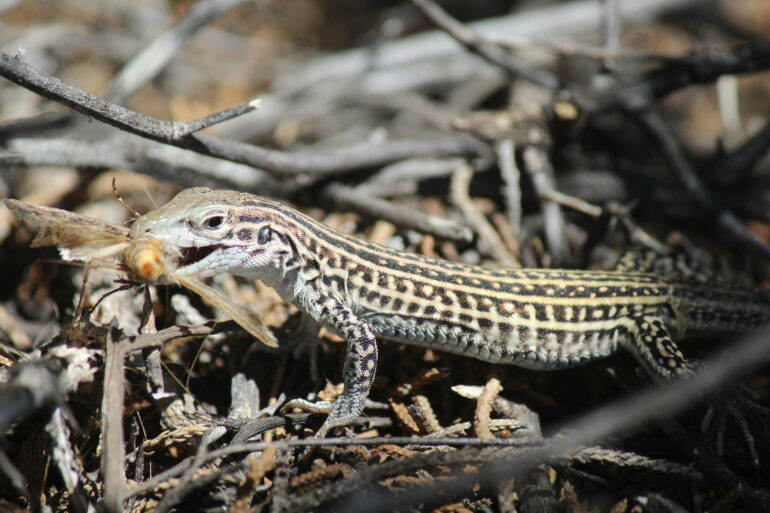Lizards may be small, with only a single hearing bonelet compared to our three, and without earflaps, but their hearing is typically good. Most lizards can hear frequencies between 100 and 5,000 Hz (although they are most sensitive between 400 and 1,500 Hz), compared to between 20 and 20,000 Hz in humans. So how do lizards react to noise pollution?
Here, scientists studied the impact of noise from low-flying military aircraft on the behavior and well-being of an uncommon lizard, the Colorado checkered whiptail (Aspidoscelis neotesselatus). This was done at the Fort Carson US military Installation near Colorado Springs, where Apache, Chinook, and Blackhawk helicopters regularly fly over, and occasionally transport aircraft and F-16 fighter jets fly over the whiptails’ habitat.
The results are published in Frontiers in Amphibian and Reptile Science. The authors emphasized that the study couldn’t have been done without the active cooperation of the US Army.
“Here we show that noise disturbance does have measurable physiological impacts on Colorado checkered whiptails. We also show that they are somewhat resilient and may compensate for this to some degree by alter their feeding and movement behaviors,” said first author Megen Kepas, a doctoral student at Utah State University.
Only females
A. neotesselatus is considered a ‘species at risk’ by the US Army, and a ‘species of special concern’ by Colorado Parks and Wildlife. The species is native to shrubland and mixed grassland along dry creek beds in southeastern Colorado, and consists exclusively of triploid females that reproduce asexually. They are about 30 cm long, including the long, thin tail that gave them their common name.
Several A. neotesselatus populations exist on the 550 square km of land belonging to Fort Carson, including the 0.05 square km of ‘Training Area 55’ (TA55), the site of the present study. Aircraft regularly fly over TA55 at altitudes below 6km.
Kepas, Sermersheim, and colleagues conducted an experimental study in 2021. They coordinated with US army pilots to fly over TA55 at prechosen times of the day between 23 and 25 June 2021, but to abstain from flying over this area earlier during the same week. On flyover dates, the noise readings at ground level ranged from 33.9 to 112.2 dB—up to the sound level of an orchestra or a power saw. On non-flyover dates, they ranged from 30.1 to 55.8 dB—up to the noise level of a humming fridge.
Each morning and early afternoon, the researchers caught as many unmarked individuals as possible, after observing their behavior for three minutes. Every female was caught only once.
The researchers weighed and measured the lizards, drew blood for hormone measurements, and took ultrasounds with a portable device to determine which females were pregnant, and if so, the number and size of their developing eggs. Caught females were marked following approved Institutional Animal Care and Use Committee (IACUC) protocols.
Back in the laboratory, the researchers measured the concentration in preserved blood samples of the stress hormone cortisol, which is typically released by the adrenal glands—under control by the pituitary—within three to 10 minutes after the onset of disturbance. They further measured the concentration of glucose, ketones, and reactive oxygen metabolites (ROMs), such as alkoxy and hydroperoxy free radicals, released by the mitochondria under oxygen stress.
As expected, the blood concentrations of cortisol sharply increased immediately after flyovers. However, glucose, ROMs, and ketone concentrations weren’t affected by flyovers.
“We found that whiptails at the Fort Carson show a stress response to aircraft flyovers, after we accounted for individual differences in body size and reproductive investment, in particular the number of developing eggs,” said Layne Sermersheim, a master’s student at Utah State University and the study’s co-first author.
Noise-stressed whiptails eat more
The results show that the lizards reacted to flyover noise by increasing their level of blood cortisol and ketones, indicative of a stress response that rapidly mobilizes more energy resources. Females with more developing eggs tended to have a higher increase in cortisol, indicating that reproductive females may be more susceptible to noise disturbance.
The clearest effects were on the whiptails’ behavior: they spent less time moving about, but more time eating when exposed to noise from flyovers.
“Compensatory eating would allow individuals to maintain their energy levels during a stressful event. This is important because metabolism, physical activity, investment into reproduction, and hormonal responses require energy,” said Sermersheim.
More information:
Megen Kepas et al, Behavior, stress, and metabolism of a parthenogenic lizard in response to flyover noise, Frontiers in Amphibian and Reptile Science, DOI: 10.3389/famrs.2023.1129253. www.frontiersin.org/articles/1 … rs.2023.1129253/full
Citation:
Lizards at US Army installation are stress eating during flyovers, shows study (2023, March 29)



